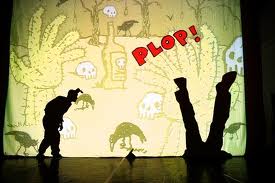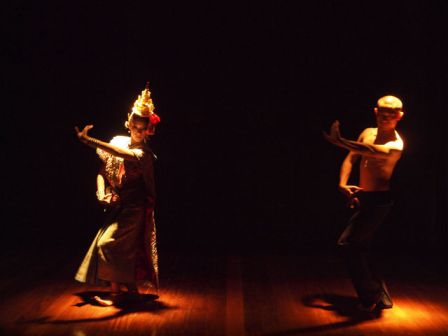Here are six Financial Times reviews from the last few weeks. They cover events at the Joyce (two), Lincoln Center Festival (three) and outside along the Hudson for the River to River Festival.
To begin, the first of two reviews of Pilobolus’s four week season at the Joyce (one week left), which features a collaboration with Art “Maus” Spiegleman (yay!):
There are two strains of Pilobolus – the illustrious dance troupe, not the lowly fungus. The first is comic, exploiting the outlandish possibilities of the human body by imagining its parts as something else: the belly button as electric outlet, the skull as a bell with the neck as its clapper, the torso as plough. The second dramatises the Kama Sutra – or tries, anyway, as hedonism may be a fine lifestyle choice but it stupefies on stage.
The two impulses – comic and sexy – cancel each other out, though this has not stopped the 40-year-old company from forcing them together in work after work. The costumes in the repertory pieces last week amounted to variations on the theme of underwear. The dramatic arcs went flat for the sake of the human origami. The soundscapes should have been consigned to a New Age nature show.
So it was a relief to find that the premieres – Hapless Hooligan in ‘Still Moving’, headlining the first of this summer’s three programmes, and Hitched, the second programme’s main event and the final piece by Pilobolus co-founder Jonathan Wolken, who died last month and to whom the season is dedicated – belong squarely in the comic camp…..
Hapless Hooligan (the shadow version) in the land of the dead. Photo by Christopher Capozziello for the Wall Street Journal. Full article here.
For my whole review, click here. (This review may require a one-time and free registration.)
I should say, the contributions of Spiegelman–with his references to early comics, early jazz, early experimental animation–wasn’t a relief to everyone. On the ladies’ bathroom line, where all secrets will eventually be spilled, I heard a member of the Pilobolus inner circle confide to a friend, “So, okay, he can play Manhattan–and maybe Florida [nudge, nudge]–but the middle of the country?”
My followup review, of another Pilobolus premiere:
What laggards the Pilobolus choreographers have become. All but one of the five works on the Joyce’s programme – the third, “Contradance” – begins in a fog or ends there. All but two, Gnomen and Pseudopodia, signal their purpose as if by weak wireless.
The four-decade-old troupe is renowned enough for its shape-shifting prowess that it is easy to overlook the theatrical savvy – until it goes missing. In the late co-founder Jonathan Wolken’s 1973 solo Pseudopodia, the evening’s best piece and its earliest, the moves are nothing special: mainly backward somersaults. But the extraordinary Jun Kuribayashi executes them so silkily – his legs switching places overhead like tongues of flame before he pulls them beneath him to complete the roll – that he comes to resemble a burning bush tumbled by the wind along an open prairie. When the flow of movement is checked – never abruptly but like the lull in a windstorm – you hold your breath. Without telling a story, Pseudopodia conjures a sense of infinitely rolling time. More often, the dances do tell a story (of sorts) and inspire only dismay.
Co-director Michael Tracy’s 2008 Lanterna Magica fails to satisfy the most basic questions, such as, “Is this on land or sea?” and “What are fireflies doing with dolphins?” The premiere….
For the whole shabang, click here.
I did a pile of research for this review of the Thai choreographer Pichet Klunchun’s Lincoln Center Festival show–and it proved barely enough to understand his “transformations” of classical form. Those of you in New York who want to learn more about the classical Thai dance known as khon might want to take a look at an hour-and-a-half documentary from 1973 of the famous “Floating Lady” episode that Klunchun excerpts. You can watch it in the research division of the Performing Arts Library, at Lincoln Center. Very worthwhile.
Pichet Klunchun’s ensemble piece Chui Chai (“Transformation”) at the Lincoln Center Festival begins with a bit of khon, a form of dance-drama cultivated in the Thai court and based on stories from the Thai Ramayana. A costume’s quantity of gold brocade, the height of a headdress’s spires and the level – floor or platform – on which a dancer reclines all signal a character’s status. But the movement tells you whether or not he is good.
Thodsakarn (Ravana in Sanskrit) – lustful kidnapper of Rama’s devoted wife Sita – is bad, for example. You can tell by the immodest splay of his limbs, the cock of his wrist to mimic a spearhead and the impatient stamp of his foot. When his niece Benyaki agrees to transform into Sita to trick Rama, the impulsive demon king sways in triumphant laughter. Benyaki’s imitation Sita, in contrast, is seamlessly fluid. Her wrists – the most eloquent part of the body in khon – draw figures in the air and her feet trace circles on the ground.
The scene where Benyaki’s flickering temper subsides into Sita’s dead calm can be mesmerising, but Klunchun – best known for his 2004 collaboration with comic French conceptualist Jerome Bel – is more interested in other transformations, namely that of Thai culture and the place of khon within it. In a pause in the action, we hear Bangkok pedestrians draw a blank when asked about Sita or assert that this one-time model Thai woman would be a sex worker today, servicing Rama and Thodsakarn alike. Soon….
For the whole review, click here.
A traditionally garbed lady in waiting in the demon king’s court and Pichet Klunchun
I had been underwhelmed by the first (for us, anyway) of Bill T. Jones’s Lincoln trilogy, Serenade/The Proposition, and had very much wanted to like it, as I could see the work in it and its thoughtfulness. So it was exciting to find the second piece solved the problems of the first, finding a way to get the diverse layers to meaningfully coexist.
When Bill T. Jones was invited to create a piece for Abraham Lincoln’s 200th birthday, he made sure it wasn’t for Black History Month. Fondly Do We Hope . . . Fervently Do We Pray reassures us too, approaching the Great Emancipator without patriotic dutifulness or bloviating.
The richly layered work for 10 dancers, two singers, a narrator and three multitasking musician-composers begins small. Gorgeous Shayla-Vie Jenkins walks on to a platform off the front of the stage and, while we listen to part of Walt Whitman’s detailed praise song of the body – “Leg fibres, knee, knee-pan, upper-leg, under-leg” reads one line – she dances with like-minded factuality, sumptuously yet precisely. Other equally individual cameos are danced to dispassionate statements of belief and scepticism: “He heard of the government of the people for those people,” warm-voiced narrator Jamyl Dobson says of an anonymous someone, “but who are those people and is he one of them?”
Throughout most of the 90 minutes, Fondly balances the warm and symbolic with the cool and concrete, the past with its sedimentation in the present, and “the people” with simply a person…..
For the whole review, click here.
It was also neat to watch, soon afterward, Jones’s homage to Merce Cunningham, in a tribute show the River to River Festival put on along the Hudson on the anniversary of the great choreographer’s death:
Last year, the Merce Cunningham Dance Company performed in Rockefeller Park along the Hudson River the day after a terrible storm and a week after the great choreographer died, aged 90. The Event, as Cunningham dubbed his seamless compilations of repertory, took place in cleansed air and sunlight, and the dance possessed a similar clarity; to have something so bright and sharp with which to say goodbye was a relief.This year hundreds of people came out on another lovely day for The River to River Festival’s Event for Merce. Five New York choreographers presented new work inspired by the Cunningham look or method, or repurposed (as we say in the Age of Trash) old work in Event-like fashion.
Tribute shows are tricky. Those who the guest of honour has had a strong hand in shaping, artistically, are hardly in a position to sort out what they have taken from him; those not under the influence may not feel enough affinity. This show erred in the latter direction – its net was cast too wide.
Faye Driscoll – at 34, the youngest of the choreographers – is a real talent, but she is driven by character and story, precisely what Cunningham left behind.
Minimalist Lucinda Childs – at 70, the oldest – may share his formalist concerns, but as the Philip Glass of dance (though plainer) she functions as an anti-Merce. Cunningham makes you feel the loveliness of such essentials of physics as time: the windows of possibility that open when things happen (as they always do). Childs works according to an airtight logic that locks out not only possibility but even probability. Inevitability prevails in dances that involve the smallest number of steps subjected to the simplest temporal and spatial schemes.
Jon Kinzel, Susan Marshall and Bill T. Jones are smarter choices….
For the whole review, click here.

Vicki Shick and Jon Kinzel at Rockefeller Park along the Hudson. Photo courtesy of the River to River Festival.
And finally, the tragedy and pathos that can be evoked with a bit of delicately assembled string and wire:
Rezo Gabriadze’s Battle of Stalingrad: A Requiem takes place on a table about six feet wide and three deep. It is an ideal size for a mammoth subject – not only the five-month battle that reduced Stalin’s model city on the Volga to rubble and ended millions of lives but, more largely, human vulnerability.
The 74-year-old Georgian playwright, director and puppetmaker depicts the relentless fighting with typical poetic economy. His five puppeteers in black stand shoulder-to-shoulder to slide metal sheets arrayed with rows of tiny helmets along the table to the beat of a spirited Soviet martial tune; when a battalion reaches the table edge, the puppeteer returns it to the back of the line, as if soldiers could be recycled and still there would not be enough of them to fill the maw of war. There never were enough for Stalin, the puppet drama suggests.
More than depicting battle, though, Stalingrad offers glimpses of the people – soldier and civilian – about to die. We meet a Berlin artist, an Odessa gunner, a Kiev handyman, a “transport specialist” (in Soviet parlance, a horse) and a people’s artist of the Bashkyr Autonomous Republic (a horse, this time of the circus variety) moments before the life gets knocked out of them.
We know these creatures – their place in society and their character – by the stuff Gabriadze has made them of and by their size…..
For the whole review, click here.
(Am sorry about few photos: blinkered computer.)



Leave a Reply